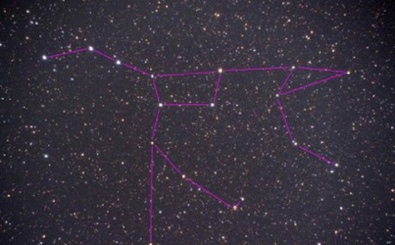Summary | Excerpt | Reading Guide | Reviews | Beyond the Book | Read-Alikes | Genres & Themes | Author Bio

Critics' Opinion:
Readers' Opinion:
First Published:
Jan 2013, 320 pages
Paperback:
Dec 2014, 336 pages
 Book Reviewed by:
Book Reviewed by:
Sharry Wright
Buy This Book
This article relates to Navigating Early
Since the beginning of time, people have been looking up at the stars, connecting the fiery dots and telling stories about the images they create in the sky. Even in modern times, we are taught to see the man with a belt and a sword, the regal chair, a big dipper and a little one; once you've located at least an approximate location, Orion, Cassiopeia's Chair, the Big and Little Dipper, are fairly easy to identify, although it takes practice and real imagination to see a dragon, a swan, a crab, an archer or the many other constellations.
 The Big Dipper is most likely the most famous and easily recognizable. Officially, the Big Dipper is not a constellation but rather part of the constellation known as Ursa Major, which means Big Bear in Latin. Often though the Big Dipper and Ursa Major are referred to interchangeably. Try as I might, I cannot see a big bear in the sky, but there are a number of cultures that base their theories on a big and little bear, telling stories to explain how they came to be. One fanciful theory, referred to in Burnham's Celestial Handbook, Volume Three, states that the choice of a bear may have come from the belief that the only creature that would brave the icy landscape of the North was a bear.
The Big Dipper is most likely the most famous and easily recognizable. Officially, the Big Dipper is not a constellation but rather part of the constellation known as Ursa Major, which means Big Bear in Latin. Often though the Big Dipper and Ursa Major are referred to interchangeably. Try as I might, I cannot see a big bear in the sky, but there are a number of cultures that base their theories on a big and little bear, telling stories to explain how they came to be. One fanciful theory, referred to in Burnham's Celestial Handbook, Volume Three, states that the choice of a bear may have come from the belief that the only creature that would brave the icy landscape of the North was a bear.
The Greeks told the story of unfaithful Zeus who changed one of his lovers, the nymph Callisto, into a bear to hide her from his wife, Hera. Arcas, Callisto's son, came across the bear one day when he was hunting. To keep him from killing his own mother, Zeus turned him into another bear and sent them both up to the sky. Together, they became the Big and Little Bear—Ursa Major and Ursa Minor.
There are a number of Native American stories about Ursa Major—the Big Sky Bear.
The Iroquois have a story about hunters chasing a bear through the forest when they ran into three giants who attacked and killed all but three of the hunters. The three survivors and the bear were transported up to the sky to continue the chase. The bear is represented by the four stars in the cup of the dipper, and the three hunters, by the three stars in the handle.
The Zuni tribe tell of a great bear who guards the west from the ice gods of the north, but when the bear goes into hibernation for the winter, the unprotected land falls prey to the frozen breath of the gods, until the bear wakes and chases them back up north.
The Navajo myth of the Changing Bear Maiden is the story of a girl who accepts a bear as her husband. When her younger sister tells their father what she's done, he kills the bear. The widowed sister turns herself into a bear for revenge. The younger sister and seven brothers try to run away but the bear changes back into a girl and chases after them, killing all but one of the brothers. The surviving brother brings the others back to life and they fly up to the sky to form Ursa Major.
Interestingly, the Greeks, Romans and Native Americans all imagined both the Big Bear and the Little Bear with long tails, whereas real bears have short stubby tails. A possible explanation for the Greek and Roman exaggeration of the tail is that Zeus must have grabbed Callisto by the tail to drag her to the heavens, thus stretching out her tail.
In ancient England, King Arthur was once said to live in the same part of the sky as the Big Bear. The constellation was later known as King Arthur's Chariot, endlessly circling the North Pole.
There are other stories about this grouping of stars that do not involve bears. In Western Africa, what we call The Big Dipper is known as The Drinking Gourd. Before the American Civil War, slaves were given the advice to "follow The Drinking Gourd" to help find their way north to safety and freedom.
A story from the Basque region of Spain tells of a man robbed of two oxen by two thieves. The angry man sent his servant, his housekeeper, and his dog to chase the thieves, but grew impatient and joined the chase himself. He and the others were taken up to the sky as punishment for his impatience— The first two stars in the cup of the dipper are the two oxen, the other two stars are the two thieves; in the handle of the dipper are the servant, the housekeeper, and the master, who is the final star. The dog is the faint star, Alcor.
In ancient China, some saw the seven stars of the dipper as the celestial palace of the star god of longevity and the heavenly mountain where the Taoist immortals resided. Others saw the three stars of the Dipper's handle as the jade scales used for weighing divine justice and measuring out the seasons.
Picture from starryskies.com
Filed under Cultural Curiosities
![]() This "beyond the book article" relates to Navigating Early. It originally ran in February 2013 and has been updated for the
December 2014 paperback edition.
Go to magazine.
This "beyond the book article" relates to Navigating Early. It originally ran in February 2013 and has been updated for the
December 2014 paperback edition.
Go to magazine.





The Flower Sisters
by Michelle Collins Anderson
From the new Fannie Flagg of the Ozarks, a richly-woven story of family, forgiveness, and reinvention.

The House on Biscayne Bay
by Chanel Cleeton
As death stalks a gothic mansion in Miami, the lives of two women intertwine as the past and present collide.

The Funeral Cryer by Wenyan Lu
Debut novelist Wenyan Lu brings us this witty yet profound story about one woman's midlife reawakening in contemporary rural China.
Your guide toexceptional books
BookBrowse seeks out and recommends the best in contemporary fiction and nonfiction—books that not only engage and entertain but also deepen our understanding of ourselves and the world around us.